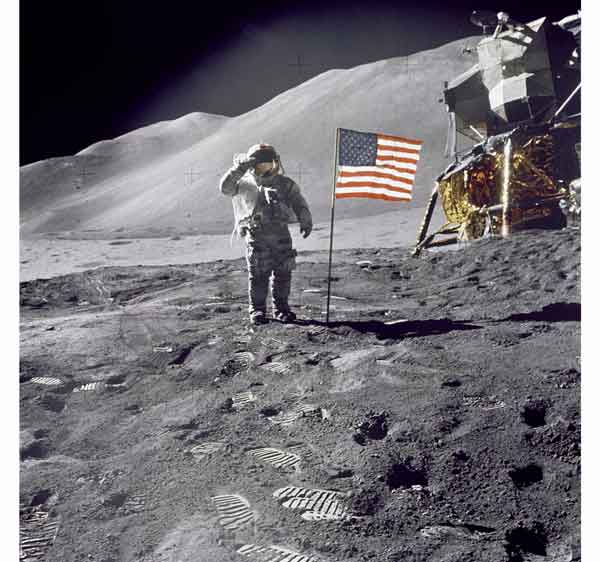Friday marked the 43rd anniversary of the landing of the Apollo 11 Eagle on the moon at Tranquility Base.
Backed by decades of work by 60,000 researchers, scientists and engineers worldwide, and supported by the leaders of 72 countries, astronauts Neil Armstrong and Buzz Aldrin became the first humans to explore several acres of desolate lunar landscape.
In essence, all of humanity landed on the moon that day in 1969.
More than 100 artifacts remain untouched on the surface of Tranquility Base. The moon has many other heritage sites from the Cold War era, when people explored it for the first time. It is critical to develop a historic preservation framework for these sites, including international agreements on how to protect the significant cultural resources.
The success of the SpaceX Dragon mission in May has laid the groundwork to transport visitors to the moon, escorted by private-sector companies. Today, for as little as a $20,000 deposit, a prospective tourist can book a space flight on Virgin Galactic.
The reality of imminent commercial space tourism is exciting — and threatening. The temptation for tourists to visit Tranquility Base, to walk in Armstrong’s footsteps or to pocket some small treasure as a keepsake may be too strong to resist. Artifacts too small to notice may be trampled. Those too large to move may be vandalized.
The three-dimensional relationship of these objects — which tells the story of the Apollo 11 crew’s activities and makes the site so significant — could be destroyed. The integrity of this historical site could be irreparably damaged. It is imperative that these artifacts be protected in their current positions.
The problem is that the objects at Tranquility Base lie in a legal gray area. By treaty, nations retain ownership to the property they leave on the moon, but no person and no country can own the lunar surface. So NASA retains ownership of its objects that are off Earth.
Recently, NASA recognized the need to protect the lunar landing sites. It received a virtually unprecedented request from Google Lunar X Prize contestants to explore how to visit the six Apollo landing sites and several unmanned Surveyor spacecraft from the 1960s.
Last year, a team of senior NASA engineers, researchers and lunar scientists as well as external experts in historic preservation drafted recommendations for any group or nation interested in visiting U.S. lunar sites.
The paper, “NASA’s Recommendations to Space-Faring Entities: How to Protect and Preserve the Historic and Scientific Value of U.S. Government Lunar Artifacts,” recognizes the significance of the sites and takes an important first step toward protecting them. It defines excluded areas within the historic sites, identifies concerns, and makes recommendations associated with descent and landing, surface mobility and contamination.
Google Lunar X Prize announced in May, during a news conference with NASA, that it intended to honor the NASA recommendations when judging teams’ mobility plans.
But Google is not legally bound to this pledge, and no one is required to observe the NASA proposals. The legal requirement to preserve American history is embedded in the National Historic Preservation Act of 1966, which created the National Register of Historic Places.
Some properties on the list are exceptionally important to our heritage and become national historic landmarks. Tranquility Base meets that criterion. Once a property is such a landmark, it can be nominated by the United States for inclusion on UNESCO’s World Heritage List, which recognizes properties around the globe that are of universal significance.
Following the lead of California and New Mexico, which listed the lunar landing sites on their respective state historical registers in 2010, we have worked with Rep. Dan Lungren, R-Calif., and his staff to draft legislation to make Tranquility Base a national historic landmark.
On this anniversary of the Apollo 11 landing, we urge the leaders of our nation, which launched the most ambitious dream on Earth and made it happen, to again take the lead in bringing nations together — this time to protect humanity’s extraordinary lunar heritage. We must ensure that our shared history is not trampled when people revisit the moon.
We did the right thing in 1969, and we can honor that achievement by working together again to protect these sites for future generations.
Beth O’Leary is an associate professor of anthropology at New Mexico State University. She was part of a team that received a grant in 2000-01 to research the Apollo 11 lunar landing as an archaeological site. Lisa Westwood is an archaeologist in California and, with O’Leary, is co-founder of the Apollo 11 Preservation Task Force. Robert Kelso, who began his career at NASA in 1973, was director of its lunar commercial services from 2007 to 2011. This column was distributed by The Washington Post, where it first appeared.
Send questions/comments to the editors.



Success. Please wait for the page to reload. If the page does not reload within 5 seconds, please refresh the page.
Enter your email and password to access comments.
Hi, to comment on stories you must . This profile is in addition to your subscription and website login.
Already have a commenting profile? .
Invalid username/password.
Please check your email to confirm and complete your registration.
Only subscribers are eligible to post comments. Please subscribe or login first for digital access. Here’s why.
Use the form below to reset your password. When you've submitted your account email, we will send an email with a reset code.